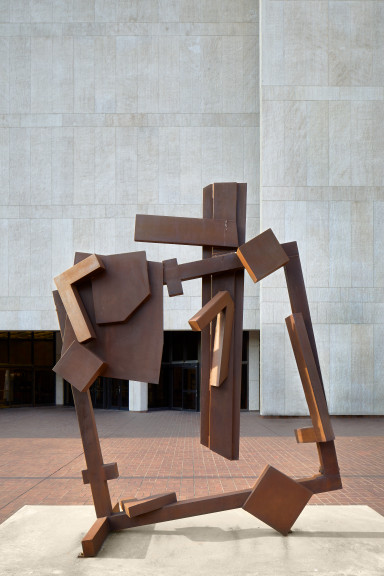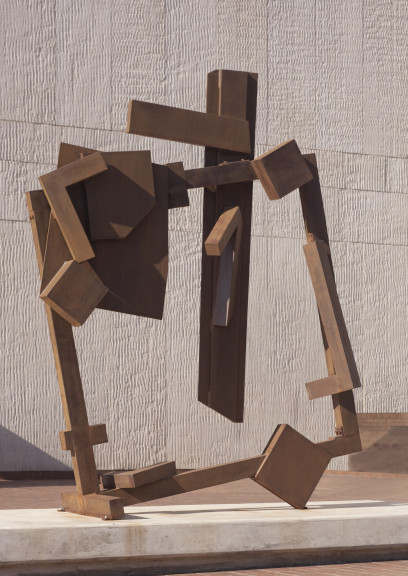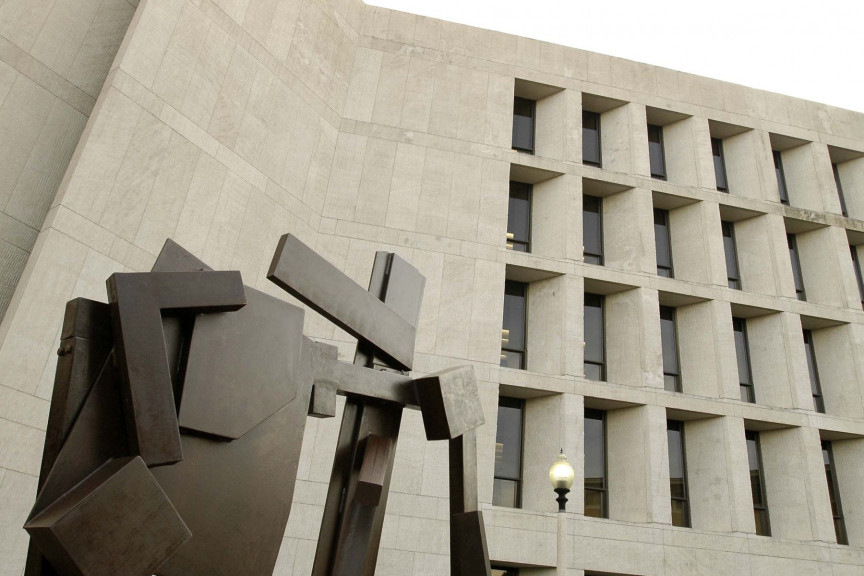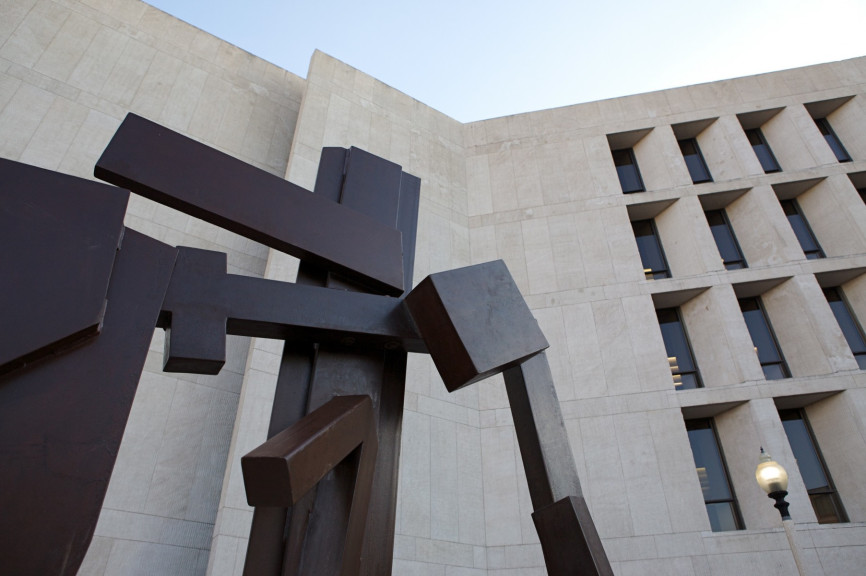Square Tilt
Joel Perlman
120 × 96 × 36 inches
Photography not permitted
Lent by The Metropolitan Museum of Art, Gift of Mr. and Mrs. L. William Teweles, 1986
1986.442a-d
GPS: 30.283087,-97.73797
Using industrial-grade steel plate to fabricate geometric abstract sculptures, Joel Perlman embraced the purely visual aesthetics championed by critic Clement Greenberg (1909–1994), prioritizing form over subject. Perlman’s works of the 1980s are pictorial, essentially flat arrangements best seen from a frontal viewpoint like a painting. He drew inspiration from the abstract compositions of the vanguard Russian artists Kasimir Malevich (1879–1935) and El Lissitzky (1890–1941). Although created in the 1910s and ‘20s, their work—characterized by the dynamic energy of geometric forms tilted on a diagonal axis—experienced a resurgence of interest in the 1960s and ‘70s.
The composition of Square Tilt likely draws from the urban architecture of Manhattan, which Perlman could see through his studio windows. While not explicitly representing the soaring cityscape, Square Tilt and other works from this period capture the characteristics of the city: powerful, broad, and monumental. Perlman allows the inherent strength and durability of the industrial steel to play a large role in the overall aesthetics.
Square Tilt typifies Perlman’s best-known compositions, which employ square or rectangular frames surrounding large openings. The sculpture functions as a window that offers viewers the opportunity to peer through a physical and metaphoric portal. Seen indoors against a blank wall, the work invites appreciation of its abstract vivacity. In other settings, especially outdoors, the large central opening interacts with its environment. Square Tilt consequently carries connotations of openness, far horizons, and passage into other domains of perception and thought. Smaller rectangles of steel plates attached to the frame introduce a harmonic interplay of forms. Despite its considerable size, Square Tilt conveys an impression of airy weightlessness.
ACTIVITY GUIDES
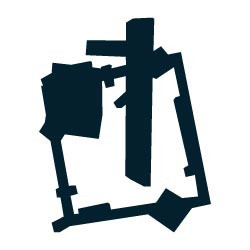
Square Tilt
Joel Perlman
Subject: Geometric abstraction
Activity: Creating a sculpture that uses a frame
Materials: Glue and different shapes or sizes of cardboard or balsa wood
Vocabulary: diagonal, geometric abstraction, horizontal, steel, vertical
Joel Perlman studied art in New York, California, and London, England. He created abstract steel sculptures that are best seen from the front, like the way we look at paintings. Perlman often creates a heavy steel frame for his sculptures and attaches smaller steel plates to it. In this way, he draws our attention to the sculpture as well as to the subject that it frames. Joel Perlman’s style is geometric abstraction.
Are the lines of this sculpture horizontal, vertical, or diagonal?
What mood do these lines convey?
Why do you think the artist named this sculpture Square Tilt?
What material was used to create this sculpture?
Using different shapes and sizes of cardboard or balsa wood, create a rectangular frame and attach geometric shapes to it. Experiment with locating it in different places and study the subjects you frame. How do the subjects change when they are framed versus unframed? How does tilting the frame at various angles change the way they look?
Diagonal – positioned on a slant
Geometric abstraction – geometric shapes that are not realistic
Horizontal – positioned the same as the horizon and the opposite of vertical
Steel – a strong dark metal
Vertical – positioned upright, like a flagpole, and opposite of horizontal
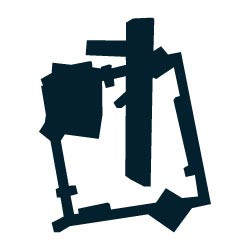
Square Tilt
Joel Perlman
Subject: Manipulation of positive and negative space
Activity: Create a shape sculpture
Materials: Cardboard or foam core, glue, scissors
Vocabulary: abstract, aesthetics, geometric, pictorial
New York native Joel Perlman received his Bachelor’s of Fine Arts (BFA) degree from Cornell University in 1965 and then attended the Central School of Art in London. He obtained his Master’s (MA) degree from the University of California, Berkeley, in 1968. Like Anthony Caro, Robert Murray, and Beverly Pepper, Perlman relied on purely visual aesthetics for his works. Using industrial-grade steel plate, he made geometric abstract sculptures, usually for outdoor display.
Perlman’s works of the 1980s are pictorial, that is, essentially flat arrangements best seen from a frontal viewpoint, like a painting. Square Tilt is typical of Perlman’s best-known compositions, which suggest windows or gateways. Often, a square or rectangular frame surrounds a large opening. Smaller rectangles of steel plate are attached to the frame. Perlman joined positive shapes to create Square Tilt, but equally important to the composition (and to the artist’s process) is negative space.
Walk around the sculpture, looking through it to the negative space. How does the environment of the sculpture influence how you see it?
Sometimes this sculpture is placed indoors. How might it change when placed indoors? What would you be likely to see through the “portal”?
How would this sculpture feel different if Perlman used organic shapes rather than geometric ones?
Perlman worked on this sculpture in a studio in New York City. Looking out his windows, he could see the high rises of the city. How do you think the space of his studio might have influenced this sculpture?
Joel Perlman begins a new sculpture by collecting steel and cutting out shapes, at least twice as many as he thinks he will use. These shapes are the basic elements that Perlman will assemble into a complete visual statement. Cut out regular and irregular shapes from cardboard or foam core. When you are done, create a sculpture. Try to think about the space around objects as well as the objects themselves.
Perlman says he loves welding steel: “It’s like magic. Touch a rod to metal, there’s a flash and buzz, and two pieces become one.”
Compare Square Tilt to Anthony Caro’s Veduggio Glimpse, Robert Murray’s Chilkat, and Beverly Pepper’s Harmonious Triad. Think about these artists’ interest in pure form. Then think about how the sculptural forms are different. While not figurative works, each of the sculptures might evoke images of familiar forms.
Abstract - expressing a quality apart from the way an object appears to the eye; the opposite of realistic
Aesthetics - a particular conception of beauty or art; a taste for or approach to what is pleasing to the senses
Geometric - based on simple geometric shapes, such as straight lines, circles, or squares
Pictorial - relating to a painter, a painting, or the painting or drawing of two- dimensional pictures
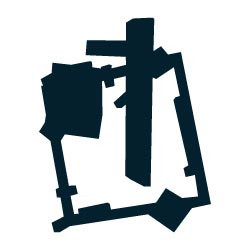
Square Tilt
Joel Perlman
Subject: Frame
Activity: Experiment with framing
Materials: Paper, scissors, tape or glue, and picture books or magazines
Vocabulary: Frame, conceal, reveal
Joel Perlman makes sculptures that often remind us of doors or windows. When we look through windows and doors, we get a limited view of what is on the other side. Pictures and paintings are often hung in frames. In sculptures like this one, the frame draws our attention to what is on the other side. It also blocks out part of our view through the frame, limiting what we can see.
How is Square Tilt like a window? How do windows frame what we see?
What do frames reveal or highlight? What do they conceal or hide?
What do you normally see when looking out a window? What do you see when you look at things that are framed?
Have your child cut out a border (the outline of a square or rectangle) from paper, as well as squares and rectangles of different sizes and shapes. Help your child create a frame with squares and rectangles that are attached to it. Place this over pictures in a book or magazine. By experimenting with this frame, ask what can you bring attention to and what can you hide?
Frame —A border around something, such as a window, door, or painting
Conceal —To hide something
Reveal —To show something, to make it visible or apparent
MORE INFORMATION
New York native Joel Perlman received his BFA from Cornell University in 1965 and then attended the Central School of Art in London. He obtained his MA from the University of California, Berkeley, in 1968.
Like Anthony Caro, Robert Murray, and Beverly Pepper, Perlman espoused the purely visual aesthetics championed by the critic Clement Greenberg. Using industrial-grade steel plate, he made geometric abstract sculptures, usually for outdoor display.
After his work was included in the Whitney Museum’s Biennial in 1973, Perlman was represented by the André Emmerich Gallery in New York, a bastion of formalist art. From 1973 through 1982, Perlman had six solo shows there. In 1973 he also taught sculpture at the School of Visual Arts in New York.
Square Tilt, 1983
Perlman’s works of the 1980s, unlike the intricate, three-dimensionality of Peter Reginato’s sculptures, are pictorial, that is, essentially flat arrangements best seen from a frontal viewpoint, like a painting. To some extent, he was inspired by the abstract compositions of the vanguard Russians Kasimir Malevich and El Lissitzky; although created in the 1910s and 1920s, those works were just being rediscovered in the 1960s and 1970s. Their purity of geometric forms was often enlivened by being tilted on a diagonal axis.
Square Tilt typifies Perlman’s best-known compositions, which suggest portals or gateways: a square or rectangular frame surrounds a large opening. Smaller, rectangles of steel plate are attached to the frame at seemingly random angles, yet they are impeccably harmonious. Despite its considerable weight, Square Tilt conveys an impression of airy weightlessness.
The composition of Square Tilt may owe a debt to the urban architecture of Manhattan, which Perlman could see through his studio windows. The sculpture continues to function as a window in any setting. Square Tilt offers us the opportunity to see through a physical and metaphoric portal. Seen indoors against a blank wall, it invites appreciation of its abstract vivacity. In other settings (especially outdoors), the large central opening incorporates its environment. Square Tilt consequently carries connotations of openness, far horizons, and passage into other domains of perception and thought.
Valerie Fletcher is Senior Curator at the Hirshhorn Museum in Washington, DC. Her research on groundbreaking aspects of international, globalized, and transnational art have resulted in numerous exhibitions and publications.
Cauman, John. “Joel Perlman.” Arts Magazine 54 (April 1980): 2.
Frackman, Noel. “Joel Perlman,” Arts Magazine, 53/1 (Sept 1978): 26.
Harn Museum of Art, University of Florida. Joel Perlman. Gainesville, 1991. Text by Ann Schroeder.
Herbert F. Johnson Museum of Art, Cornell University. Joel Perlman: A Decade of Sculpture, 1980–90. Ithaca, NY, 1990. Text by Leslie Schwartz.
Kaplan, Gene. “Joel Perlman’s New Sculpture.” Arts Magazine 57 (October 1982): 110–11.
Maxwell, Douglas F. “Joel Perlman: Dynamic Geometries.” Sculpture 21 (July/August 2002): 42–45.
Messinger, Lisa Mintz. “The Recent Sculpture of Joel Perlman.” Arts Magazine 59 (June 1985): 134–35.
Palmedo, Philip F. Joel Perlman: A Sculptor’s Journey. New York: Abbeville Press, 2006.
Saunders, Wade. “Joel Perlman at Emmerich.” Art in America, 66 (September/October 1978): 123–24.
The Metropolitan Museum of Art in New York generously loaned twenty-eight modern and contemporary sculptures to Landmarks for display throughout the Austin campus. The collection represents a broad array of artists working in the second half of the twentieth century. The initial sculptures were installed throughout the main campus in September 2008, and a second, smaller group were unveiled at the renovated Bass Concert Hall in January 2009.
Funding for the loan was provided by the Office of the President. This project was the result of a collaborative effort among many, including:
Leadership
Andrée Bober and Landmarks
Pat Clubb and University Operations
Douglas Dempster and the College of Fine Arts
Landmarks Advisory Committee
William Powers and the Office of the President
David Rea and the Office of Campus Planning
Bill Throop and Project Management and Construction Services
Gary Tinterow and the Metropolitan Museum of Art
Samuel Wilson and the Faculty Building Advisory Committee
Project Team
Chuck Agro, transportation, Metropolitan Museum of Art
Andrée Bober, curator and director, Landmarks
Caitlin Corrigan, registrar, Metropolitan Museum of Art
Cynthia Iavarone, collections manager, Metropolitan Museum of Art
Cliff Koeninger, architect
Ricardo Puemape, Project Management and Construction Services
Kendra Roth, conservator, Metropolitan Museum of Art
Patrick Sheehy, installation services
Nicole Vlado, project manager, Landmarks
Special Thanks
Valerie Fletcher, curatorial contributor
Beth Palazzolo, administrative coordination, University Operations
Russell Pinkston, composer
What’s Past Is Prologue: Inaugurating Landmarks with the Metropolitan Sculptures
With the arrival of twenty-eight modern sculptures on long-term loan from New York’s Metropolitan Museum of Art, the Landmarks program has begun. Their installation throughout the Austin campus offers a remarkable opportunity to survey some of the major trends in art during the second half of the twentieth century. These sculptures allow us to witness the distinctly modern dialogue between representation and abstraction, as well as the contest between natural and industrial materials. Most of all, we can celebrate their presence as an unprecedented chance to experience works of art first-hand––to appreciate their forms and to understand the underlying ideas.
The Landmarks program perpetuates in Austin one of civilization’s oldest and most enduring traditions: the placing of art in public areas, accessible to nearly everyone and expressive of collectively held ideas. More than five thousand years ago, the cultures of Egypt and Mesopotamia produced sculptures for urban plazas, government buildings, and places of worship to express political, secular, and religious values. Grand monuments endorsed the ruling elite and commemorated military victories, while images of deities symbolized spiritual beliefs. The original purposes of public art were primarily ideological and didactic, but what has endured through the ages is the physical beauty of the art. In modern times the contexts and goals for public art have changed considerably. In many parts of the world democracy and egalitarianism have supplanted absolute rulers, and explicit religious power has yielded to secular humanism. During the mid-to-late twentieth century (the era when the Metropolitan’s sculptures were created), globalization has redefined the entire world. Societies in Europe and the Americas have became so diverse that cultural authorities can no longer be sure of which systems of meaning and which values, let alone which individuals, should be honored in the traditional ways of public art.
A schism has developed between traditionalists and modernists. In a rapidly changing world those who wanted to preserve the familiar in art have continued to commission representational statues. Modernists, on the other hand, have embraced change and gladly jettisoned the old ways in favor of abstraction. The schism is exemplified by two famous memorials in Washington, D.C., both intended to commemorate the heroic sacrifices of American armed forces. The Marine Corps Memorial (1954) consists of a superbly realistic representation of soldiers struggling to raise the American flag on Iwo Jima in 1945. In contrast, the Vietnam Memorial (1982) consists of a massive V-shaped wedge of polished black stone inscribed with What’s Past Is Prologue: Inaugurating Landmarks with the Metropolitan Sculptures July 2008 the names of the dead. At the time it was inaugurated, this monument shocked nearly everyone outside the art world and outraged many of those it intended to commemorate. In response, a group of bronze figures of soldiers was added. But soon, precisely because of its universal form and absence of imagery, the original memorial became a powerful place where all Americans could go to grieve, remember, and pay homage. To most of the art world, this demonstrated beyond a doubt the viability of abstract sculpture for public places.
With America’s increasing wealth and social consciousness in the 1960s many towns began to institute programs of commissioning sculptures for public places. By requiring that 1 or 2 percent of each building’s construction budget be used for art, urban planners sought to improve the living and working environment for millions of people. The main difficulty was agreeing on what kind of art was visually pleasing and, just as important, potentially meaningful to the general public. Two highly publicized examples were the huge, abstract, metal sculptures by Pablo Picasso and Alexander Calder, in Chicago and Grand Rapids respectively, which at first provoked derision but gradually became a source of community identity and pride.
One way to approach works of art is to consider the historical context in which they were created. During the first half of the twentieth century, life and art underwent radical transformations. Industrial manufacturing supplanted agriculture as the dominant mode of production, people migrated from rural areas to urban centers, women and minorities gained equal rights, warfare expanded to an unprecedented global scale, and technology accelerated the pace of life—and art changed in tandem.
Abstraction
Early in the modern era, many artists believed that a new visual language was needed to replace the Greco-Roman classical figurative traditions that had persisted through two millennia. Photography had made mimesis (accurate depiction of reality) unnecessary in painting and sculpture for the first time in history. Artists were free to conceive radically new approaches, and so abstraction was born, emerging from 1910 to 1920 in Europe. Initially artists simplified and stylized observed reality into organic and angular forms. That first phase soon evolved into making “pure” abstractions with no recognizable sources. From the outset, abstract art carried implicit meanings recognized by artists and informed viewers but largely lost on the general public.
Early abstractionists intended their art to convey their commitment to an ongoing transformation of society. Like Morse code in telegraphy and other new modes of communication fundamentally different from the traditional written word, abstract forms in art could convey meanings—not narrative or literal ones but broad ideas that could speak to an international audience and help advance human consciousness.
During the 1920s and 1930s, artists developed two broad types of abstraction: geometric and biomorphic. Geometry denotes mathematics and suggests such related disciplines as architecture, design, engineering, and logic as well as intangible qualities like analytical thinking and precision—desirable attributes for a rational, communal society. Artists devised a new language of geometry in art: horizontal and vertical elements can convey calm, harmony, and stability (see Harmonious Triad by Beverly Pepper), while rising diagonals can suggest energy and optimism (see Column of Peace by Antoine Pevsner and Square Tilt by Joel Perlman).
In contrast to geometric abstraction, a number of artists favored softer forms and curving contours. Inspired by sources in nature, biomorphic abstractions evoke natural phenomena, biological processes, growth, and ambiguity (see Big Indian Mountain by Raoul Hague, Source by Hans Hokanson, and Untitled [Seven Mountains] by Ursula von Rydingsvard). Such works stand in general opposition to the industrial and technological aspects of modern life; they remind us of the fundamental importance of the natural world. Biomorphism was invented and advocated by the surrealists, who believed in the importance of the unconscious mind in creating and understanding modern art. Relying on the Freudian concept of free association, such artists expect viewers to generate their own unique responses to abstract art.
The two types of abstraction began as competing and opposing philosophies, but by the 1950s many artists expertly combined them to suit their expressive needs (see the rhythmic contours of Veduggio Glimpse by Anthony Caro and the disconcerting, hulking forms of Catacombs and Guardian by Seymour Lipton).
By the 1960s, the original philosophical meanings underlying abstraction had mostly faded away, leaving “formalist” aesthetics: the creation and appreciation of pure nonreferential beauty. Formalism dominated much artistic practice from the 1950s through the 1970s, particularly in the United States in the circle around the critic Clement Greenberg. Geometric sculptures became ubiquitous in public places—some complex and sophisticated and some merely competent. A group known as the minimalists advocated an intellectually rigorous, austerely reductivist approach (see Amaryllis by Tony Smith). Other artists went in the opposite direction, toward complexity and a decorative verve (see Kingfish by Peter Reginato). From those extremes emerged the postminimalists, who infused organic vitality into simple, singular forms (see Curve and Shadow No. 2 by Juan Hamilton).
Figuration
Despite the enthusiasm for abstraction in midcentury, a number of artists insisted on maintaining recognizable human content in their works. Abstraction had alienated many viewers who found it remote or incomprehensible. Yet few artists returned to traditional realism, preferring instead to explore new and evocative modes of representation.
The strongest resurgence occurred in the aftermath of World War II. Many artists, especially in Europe, wanted to pay homage to the sufferings experienced by so many people during the war and to their struggles to rebuild their lives and societies amidst the new fears engendered by the nuclear age and the Cold War. This atmosphere of postwar existential anxiety was poignantly expressed in two museum exhibitions in the 1950s: models for a never-realized Monument to the Unknown Political Prisoner at London’s Tate Gallery in 1953 and the avowedly humanist theme of the New Images of Man installation at New York’s Museum of Modern Art in 1959.
Many postwar sculptors expressed their angst by portraying figures or fragments of bodies as falling, broken, injured, or partially robotic (see Augustus by Bernard Meadows and Figure by Eduardo Paolozzi). Some erudite artists reinterpreted classical myths, particularly those in which a hero challenged the gods and were punished: Icarus, Hephaestus, Prometheus, Sisyphus (see works by Koren der Harootian and Frederick Kiesler). Seymour Lipton created a particularly effective amalgam of figure references within abstract forms that harbor dark inner spaces (see Pioneer, Catacombs, and Guardian).
Representational sculpture was submerged by the tidal wave of abstraction in the 1960s and 1970s, but a new generation insisted on a legible humanist content in art, addressing issues of personal identity and isolation in an impersonal world (see Eyes by Louise Bourgeois and Figure on a Trunk by Magdalena Abakanowicz).
Materials and Methods
Modern sculptors also introduced a new language of materials and methods. In the late nineteenth century, sculpture making had entered a new phase of mass production made possible through technology: bronzes could be produced in large editions by skilled technicians from an artist’s original. The Thinker by Auguste Rodin, for example, was made in several editions, ranging from a dozen life-size bronzes to hundreds of smaller casts. This mechanization and concomitant commodification of art prompted a reaction. Appearing simultaneously in several countries, the “direct carve” movement advocated older craft-based methods and sought to enhance the intrinsic characteristics of natural materials: the color and grain of exotic woods or the veining and crystalline structure of unusual stones. By the 1920s, this aesthetic had gained international prominence, and it persists to this day.
The first generation of direct carvers admired prehistoric, African, Oceanic, and indigenous American artifacts. By adapting the hieratic frontality and stylized forms of those sources to the sleekly refined forms of abstraction, modern sculptors could represent simplified figures linked in sophisticated linear rhythms (see works by Koren der Harootian and Anita Weschler). Recent artists of this orientation tend to work on a larger scale and may roughly cut and hew wood to achieve expressionistic textures (see works by Hans Hokanson and Ursula von Rydingsvard).
Carvers remained a relatively small minority in modern sculpture, far outnumbered by “direct metal” sculptors. Their approach emerged in prewar Europe and burgeoned into an international movement in the 1950s and 1960s. Seeking materials and methods appropriate to the modern Machine Age, artists looked to engineering and construction for inspiration. Instead of using chisels to carve wood and stone, constructivists preferred welding torches to cut and join pieces of metal. Their structures ranged from elegant abstractions to assemblages of cast-off objects.
The industrial analogy and model extended to the sculptors’ own studios, which resembled factory spaces with heavy-duty equipment. Some—like Anthony Caro, Willard Boepple, and Robert Murray—found inspiration in working spontaneously and experimentally with sheet metal: cutting, folding, rolling, welding, soldering, and sometimes painting or burnishing it. Other sculptors, notably Tony Smith, were comfortable with sending models to factories for professional fabrication. Both methods were considered appropriate for a modern world that had been so fundamentally reshaped by industrial manufacture.
In contrast, many sculptors preferred to make assemblages from miscellaneous bits and pieces of scrap, sometimes irreverently called “junk sculpture.” Although artists had experimented with this approach as early as the 1910s, it became a widespread tendency only decades later in the 1950s and 1960s, when sculptors made three-dimensional collages from the detritus of industrial manufacture and mass consumption: rusty machinery, old car parts, squished used paint tubes, broken musical instruments, virtually anything. The motivations for using trash range from simple necessity (when an artist has no money to buy new materials) to antimaterialistic social criticism and environmentalism (sculptors started recycling long before the idea occurred to others).
Regardless of the motivations, a found-object sculpture possesses an inherent dual identity: its former reality as a useful thing and its new reality as art. That dualism inevitably poses an intellectual and visual conundrum for us. Do we see Deborah Butterfield’s Vermillion primarily as a lifelike depiction of a horse or as a composition of rusty, crumpled bits of metal thrown out by a wasteful consumerist society? And what are we to understand from Donald Lipski’s seemingly abstract The West, which consists of decontextualized harbor buoys and lots of corroded pennies? The artists offer clues and hope that we will use our own eyes, intellect, intuition, and imagination to make connections and create meanings.
Landmarks: Sculptures for Inquiring Minds
Unlike works in private collections or even museums, public sculptures exist in our daily environment, interact with our activities, and enter our awareness repeatedly and variously. Beyond the pleasure they bring to viewers already acquainted with art, they can stimulate curiosity and spark new perceptions in the minds of passersby who might otherwise not have much aesthetic experience. As the university’s population seeks knowledge in classes, libraries, and laboratories, the Landmark sculptures can offer other kinds of discoveries. Visitors to the Perry Castañeda-Library, the Nano Science Technology Building, the School of Law, and elsewhere on the campus can now see immediately that the visual arts have a prominent place and come away enriched. Very few campuses or cities can boast so many sculptures of such quality that are free and accessible to all. The twenty-eight sculptures from the Metropolitan Museum of Art proclaim the broad purpose of the Landmarks program: to bring an important new dimension to the life of the university, to the everyday experience of its students, faculty and staff, the citizens of Austin and beyond, and to any person who just crosses the campus.
Valerie Fletcher is Senior Curator at the Hirshhorn Museum in Washington, D.C. Her research on groundbreaking aspects of international, globalized, and transnational art have resulted in numerous exhibitions and publications.

